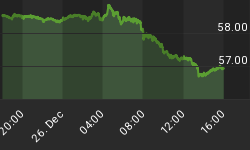Since the current gold bull began in 2002 - or when the price of gold finally held above $300 an ounce - the Commitments of Traders report (COT) has been a crystal ball. To be sure, from 2002 until August 2005 the knowledge gleaned from weekly COT led to timely buy and sell recommendations, many which were publicized in this space.*

But alas, times change: Over the last 14-COT weeks the commercials have covered their net short position based as a percentage of open interest (futures & options) for a loss on 6 different occasions, including an unprecedented 3-week losing streak (Jan 3, 2006-Jan 17, 2006). As per a continuation of the above chart, what once seemed like a strategy that was too good to be true has proven to be exactly that.

Although the silver COT's predictive powers were never as strong as with gold, they nonetheless followed similar tendencies. For lack of a better way of putting it, over the last 6-weeks the silver commercials - which, if you remember, are always net short - have been slaughtered.

Was It All Just A Dream?
On the surface the destruction of COT should mean skyrocketing gold prices, commercial defaults, and that your local gun shop is out of inventory. After all, the song since the late 1990s has been that if the commercials ever tried to cover their short position they would be unable to buyback nonexistent gold/silver (to cover their borrowings from the evil central banks). Unfortunately (at least for gold bulls) this has not been the case.
What has been, and remains the case, is that the average investor lacks the tools to dig deep. To be sure, with new gold ETFs attracting investor dollars, OTC derivatives positions not known, and lease rates still at historically low levels, not all of the score can be heard by listening to COT alone. In other words, the destruction of the COT doesn't necessarily mean the destruction of the manipulating forces that have been at work for more than a decade.
Yes, with limited vision it can be said that the commercials have shown a willingness to eat some losses and that this has, justifiably so, thrown into question the very idea of commercial control of the gold market. But before quantifying many years of seemingly blatant manipulation as a bad dream the big question is whether a 14-week losing streak erases nearly 200-weeks of control? Sadly this question can not be answered today.
Controlling Your Profits & Losses
4-years ago no one thought much about a gold bull; Wall Street had long taken the anti-paper asset class off its radar, gold producer's sold future production for fear of falling prices, and central banks (even after the Washington Agreement) were still a major supply threat. Contrast this situation to today and entirely different animal is seen: Wall Street is packaging and selling gold/silver/commodity ETFs, new gold exchanges and markets are popping up around the world, producer hedging has almost been eradicated, and there has been no major central bank sale rumors/surprises in many years.
Based on the above information the trend watcher would no doubt conclude that the price of gold is headed for even brighter days. And while this may well be the case, the already profitable gold bull can not help but grow increasingly less optimistic with every rally. Why become less bullish on gold even when the US twin deficits and/or the trend of central bank diversification away from USD ensure that the long-term outlook for gold remains super-bullish? Because the fundamentals do not immediately dictate market price, and gold has already rallied by a fantastic amount.
As for the commercials, despite being bloodied the gold commercials are still net short 160,585 contracts (futures & options). This is an enormous short position. It wasn't that long ago that the commercials were net long, and gold was a raging contrarian buy (the last time the commercials were net long was on December 11, 2001. Gold was at $272 an ounce).
In short, once upon a time, and for a very short period of time (2002-Aug 2005), it was easy to buy and sell gold before key market turning points. With COT tendencies disappearing and gold's popularity growing, the gravy days are over.
Disclosure: Todd and I own gold/silver coins and bullion.
* Two timely historical suggestions were to sell silver 'unless the jig was up' on April 7, 2004 (on April 8, 2004 the price of silver began to crash, losing more than 30% in less than 1-month) and to buy silver on May 12, 2004 (or 1-day before the price of silver reached what a multi-year bottom of $5.55 an ounce).
















